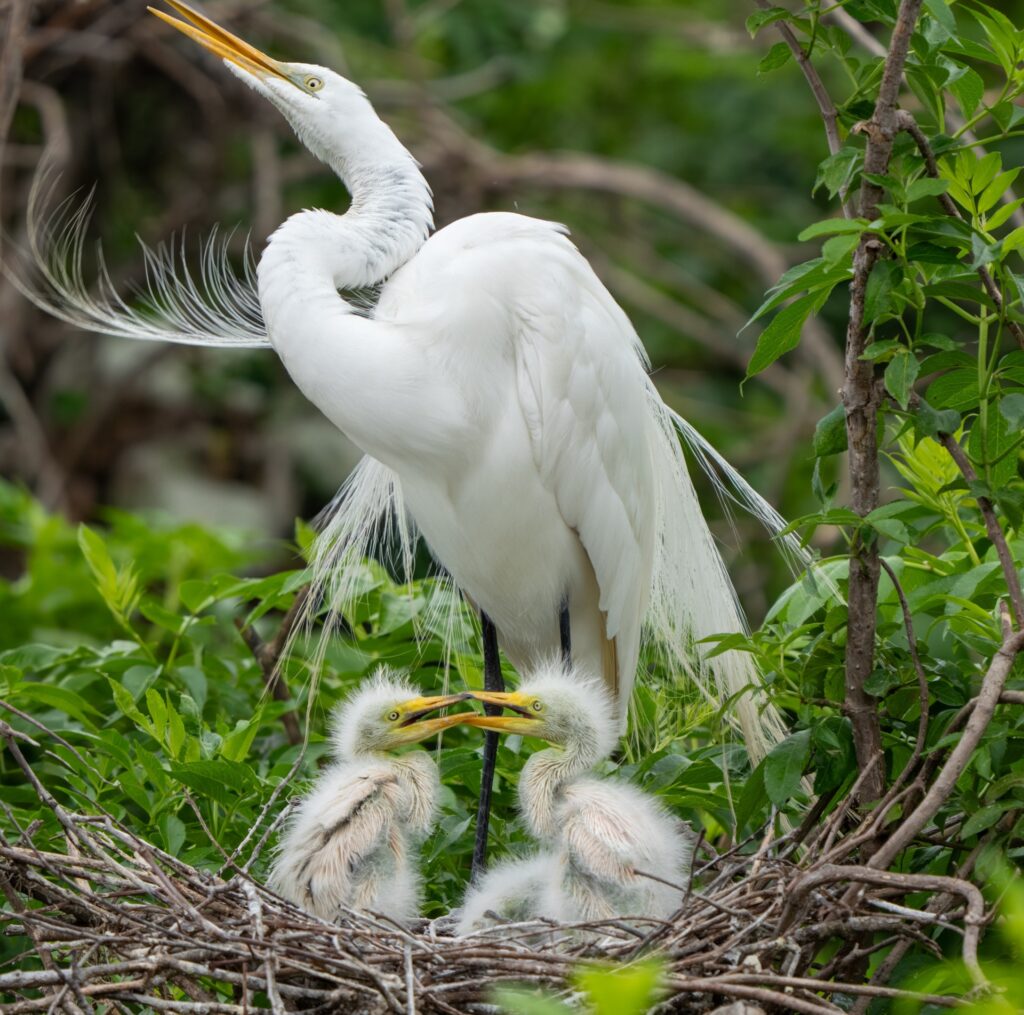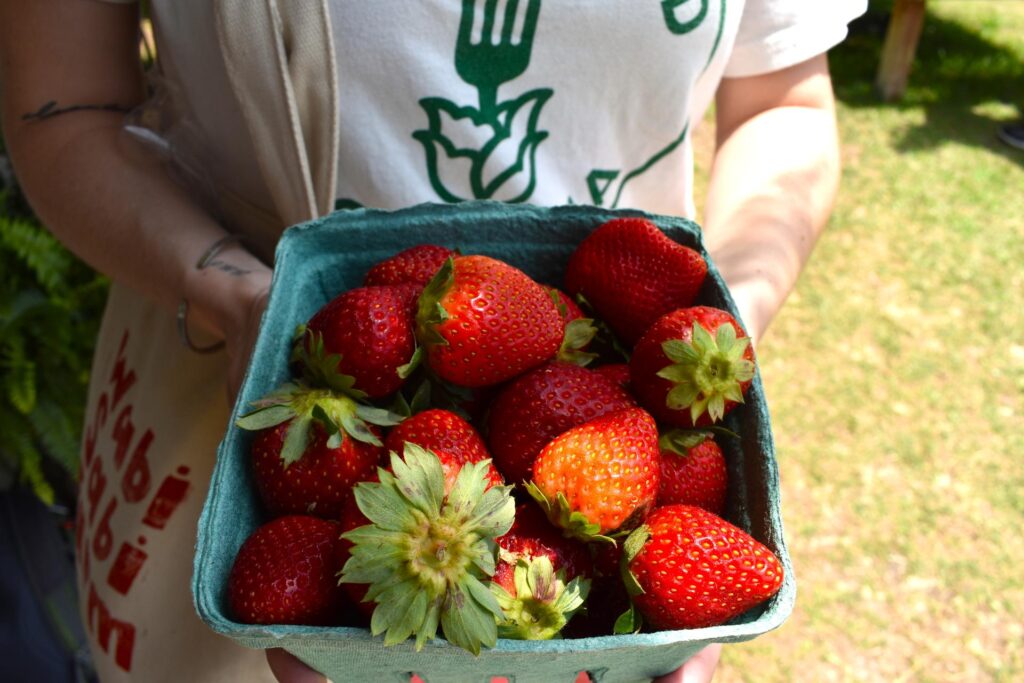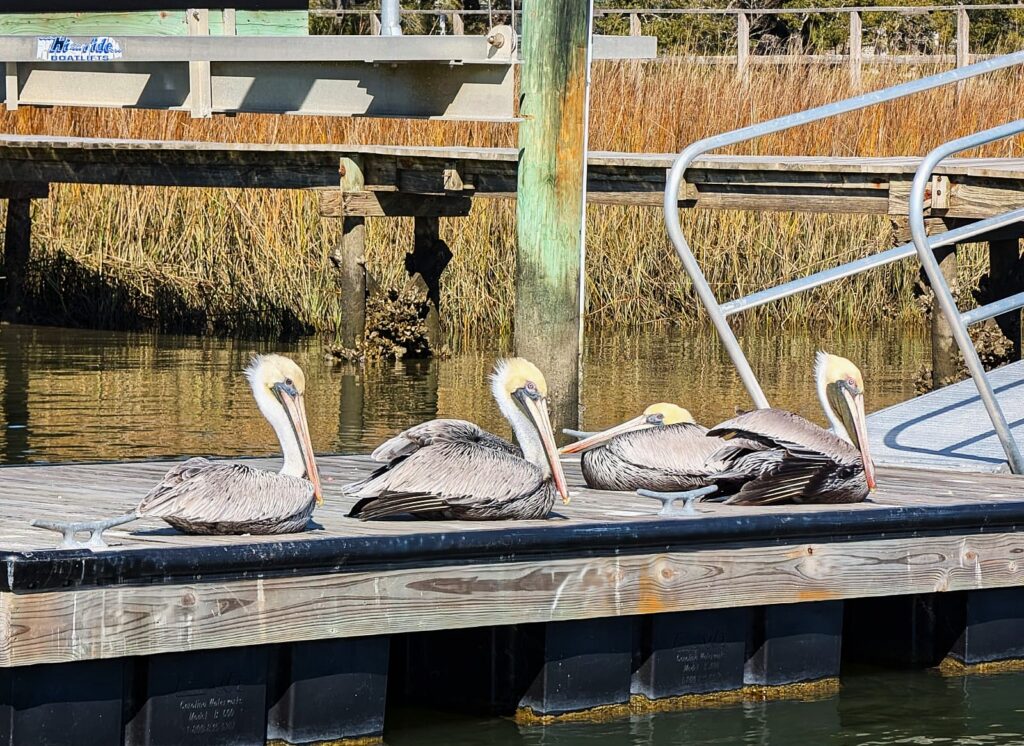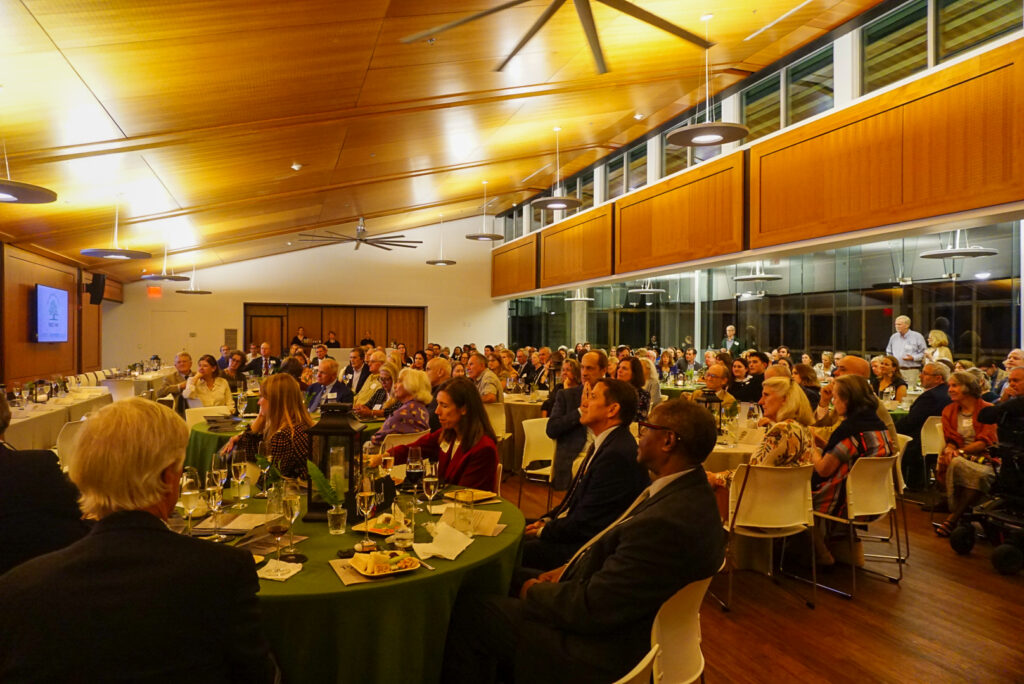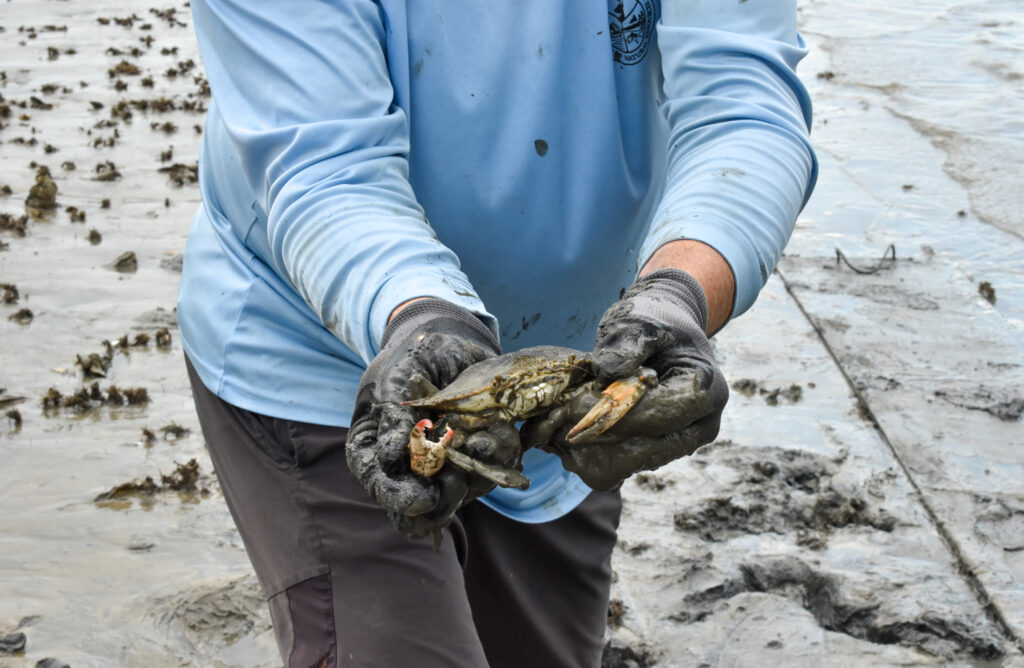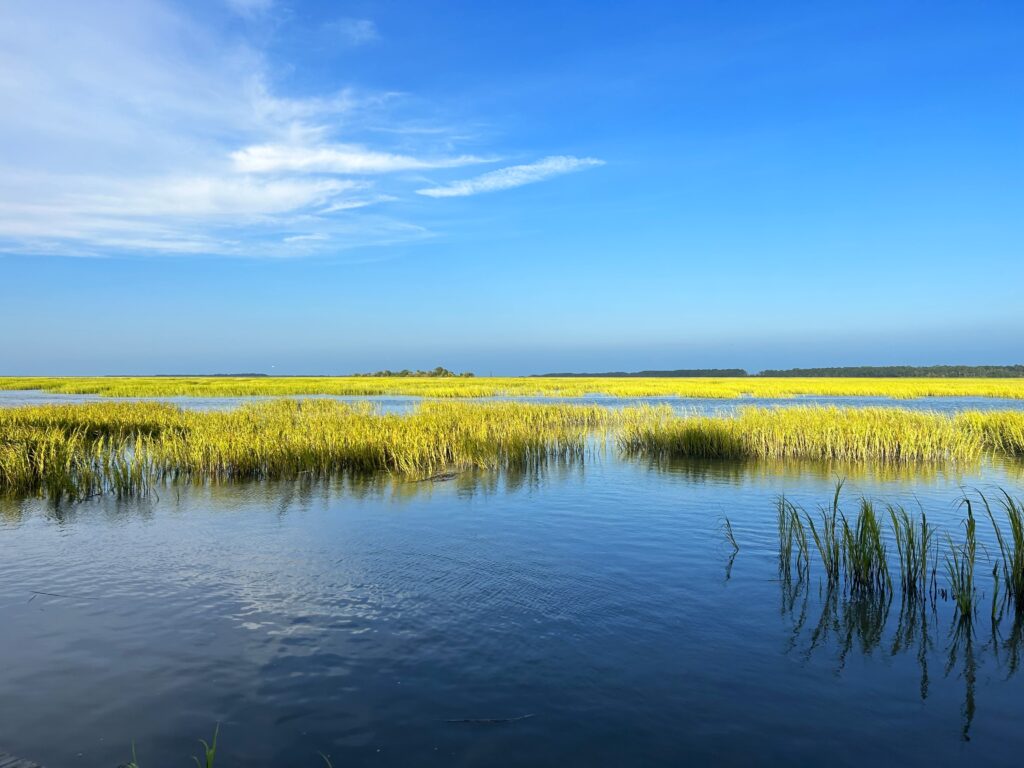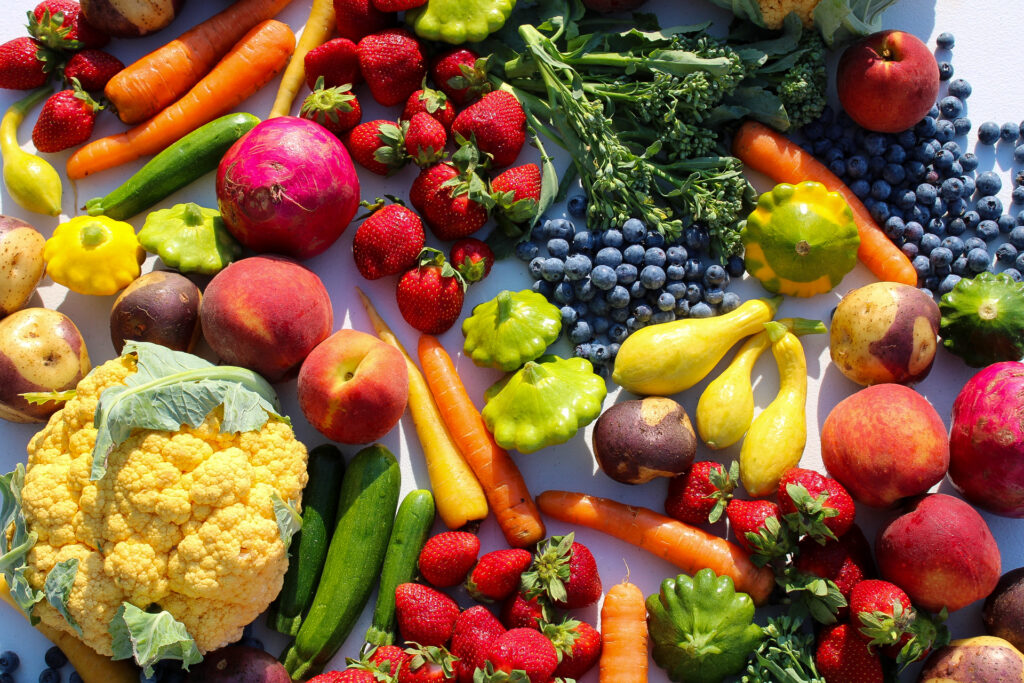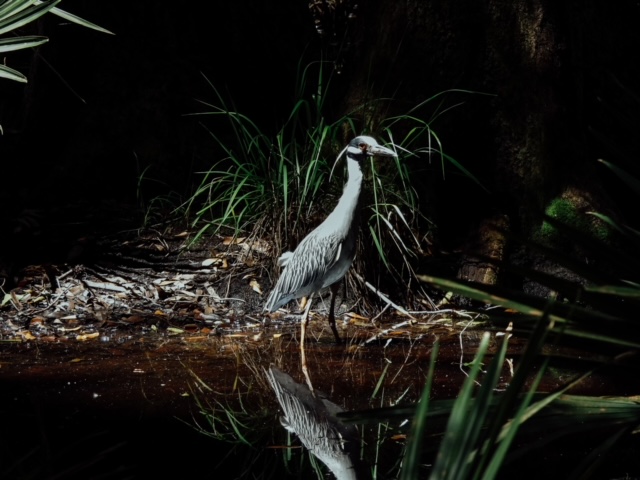Every month our Coastal GEMs and Coastal Legacy Society receive a Photo of the Month in their inboxes. We hope you enjoy these photos that capture this incredible place we call home and what we work to protect.
June 2025
A stunning capture of a Great White Egret hovering over two chicks, courtesy of Conservation League Member Robert Anderson, portrays a beautiful depiction of nature and the cycle of life.
The male egret selects a nest location and after the female lays 3-4 eggs, both parents take turns brooding–protecting their territory and their successors.
Have you ever thought about the next generation and what our coast will look like for them? If you’d like to learn more about how you can leave a lasting legacy for conservation visit our bequest page and join our Coastal Legacy Society.
What do birds call other birds that live nearby?
Nest-door neighbors
May 2025
After a beautiful and educational walking tour through Wabi Sabi Farm in Cordesville on a warm day, I was more than excited to take home these farm-fresh and delicious red strawberries. Communications Manager Emmi Palenbaum snapped this picture of my precious pint, illuminated by the sunlight bursting through the tall longleaf pine trees surrounding the property.
A GrowFood Carolina partner since 2011, Wabi Sabi Farm is a family run farm and event space primarily focused on growing vegetables, fruit and u-pick strawberries using sustainable agricultural practices.
Earlier this month, the owners led Conservation League staff and community members on a tour talking about their partnership with our food hub, their produce growing experience, and the trials and tribulations of owning a farm – highlighting why supporting local family farms is so crucial.
GrowFood Carolina is focused on working with farms like Wabi Sabi to maintain the rural character of our region and to increase access to local foods around South Carolina.
Why do strawberries make great musicians?
Because they know how to jam
April 2025
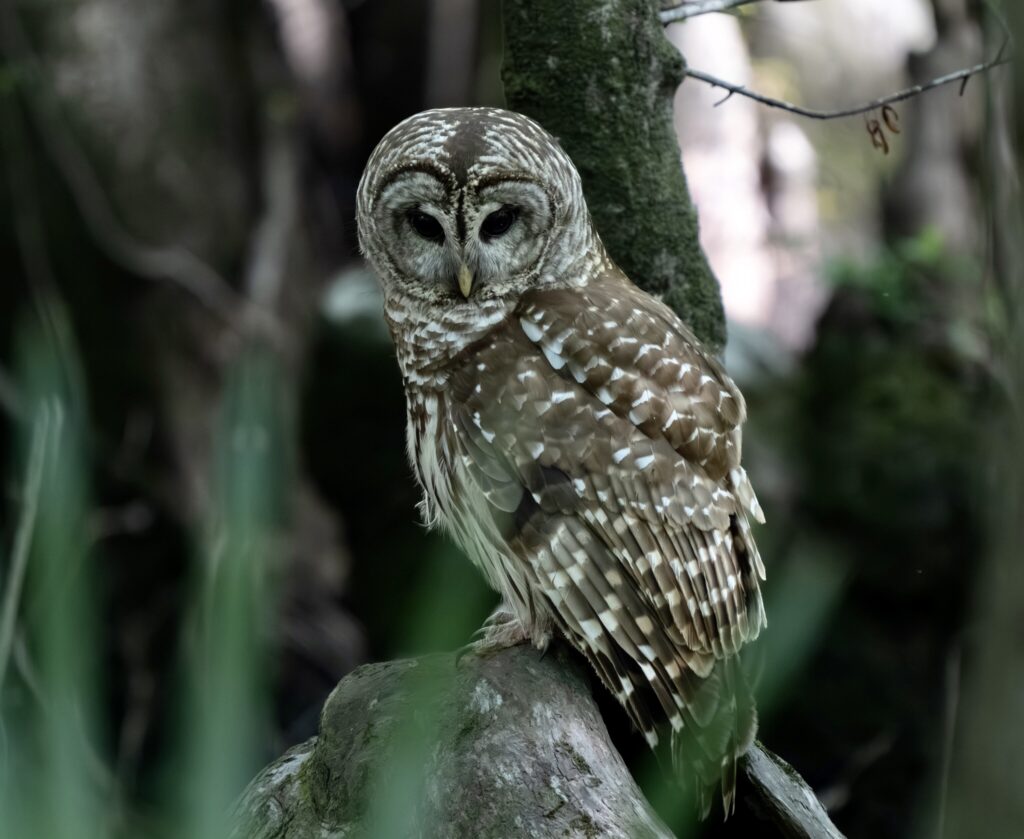
During a recent Beidler Forest trip, Conservation League Member Robert Anderson captured this striking image of a majestic Barred Owl, seemingly staring directly into the eyes of the viewer.
Did you know that the oldest recorded Barred Owl was over 26 years old? And they’ve been around for much longer – fossils of the owls, at least 11,000 years old, have been discovered in Florida, Tennessee, and Ontario.
What do you call and owl that is bad at hide and seek?
A Spotted Owl!
March 2025
During a recent birding walk at Roxbury Park with the Coastal Conservation League and Charleston Bird Club, I stopped for a minute to snap this photo, and to spot a Brown Thrasher. Illuminated by the morning light, live oaks draped in Spanish moss intertwined with glowing vines of Carolina jessamine. Somewhere in there too, there’s a bird or two.
We spent the morning looking up and out – with binoculars in hand – at the sky, treetops, and into the fields. We spotted 48 species of birds, including one of my favorites, the American Kestrel.
Did you know that at one time Roxbury Park was slated for a 60-home development? Fortunately, the site never came to fruition. After vocal opposition from the community to developing the land, the Town of Meggett was able to secure Charleston County Greenbelt funding and turn the area into a public park in 2013 – an excellent story of a rural community protecting its character.
How do you protect an oak tree?
You root for it!
February 2025
Land, Water, & Wildlife Project Manager Brooke Blosser captured these pelicans soaking up the February sunshine on Shem Creek.
Did you know that during the 2024 legislative session the Eastern Brown Pelican was named the official Seabird of South Carolina?
First described in the Charleston Harbor in 1789, this iconic species relies heavily on the South Carolina coastal habitat for nesting, including seabird sanctuaries Deveaux Bank and Bird Key. This designation highlights the importance of preserving and enhancing the habitat of this species and other seabirds along our coast, and serves as a symbol of South Carolina’s commitment to environmental stewardship and wildlife conservation.
Why did the pelican get kicked out of the restaurant?
He had a big bill but no wallet
January 2025
South Coast Office Project Manager Grant McClure captured this serene, snowy marsh scene in Beaufort where community members, in true Lowcountry fashion, can be seen using boogie boards as snow sleds.
The first month of 2025 has been off to a chilly start with Beaufort County and many other areas experiencing their first snow fall in 7 years this week.
While these freezing temperatures and snow may not be convenient, they can encourage us to take a break from our every day lives and make a connection to nature (safely, and without having to travel on icy roads!). And, if witnessing snow fall in the Lowcountry was on your new year’s resolution list, you’re off to a great start!
Why are snowmen great at parties?
They always know how to break the ice
December 2024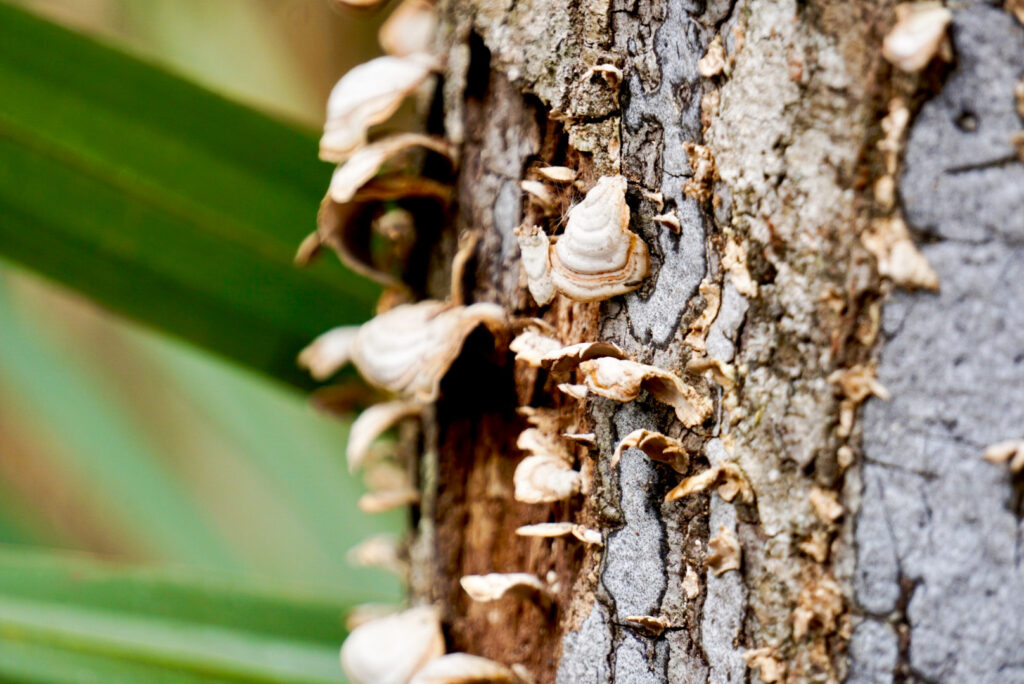
Calling all mushroom enthusiasts! During a walk at Caw Caw Interpretive Center, I captured these funky fungi growing on a cypress tree, but I need your help. My first guess was turkey-tail mushroom, but I may be easily fooled by the false turkey-tail, Stereum ostrea, which looks strikingly similar. True or false–can you identify this?
Other than a tasty dish to incorporate into your holiday recipes, mushrooms can offer numerous health benefits, from boosting your immune system to helping improve cancer survival rates. Stereum ostrea, on the other hand, has a rough texture that makes it unsuitable for human consumption–it’s not poisonous, but it’s not known to offer the same extraordinary benefits of its look-alike.
Did you know that in 2014, the Coastal Conservation League worked with Tradd Cotter, a mycologist who studies fungi, and the former DHEC to develop a statewide certification program? The state’s first Wild Mushroom Safety Certification was held at Charleston’s Caw Caw Interpretive Center in 2014 and, following South Carolina’s lead, other states embraced the certification program, which allows people to forage and sell what they have gathered.
How much space do fungi need to grow?
As mush-room as possible
November 2024
Members, partners, board members, and staff fill Founders Hall at Charles Towne Landing for our recent 35th anniversary celebration. It was an inspiring evening for the future of conservation, and a time for recognizing past accomplishments and looking forward to what’s next.
Feelings of appreciation are especially present this week while we all think about who and what we are thankful for.
Here at the Conservation League, we are thankful for YOU! We’re thankful for all that you do to safeguard our coastal environments, communities, and wildlife that we all love. It’s a collaborative effort to protect our coast and we are truly grateful to have you by our side.
What do you call rain on Turkey Day?
Fowl weather
Why should you never tell secrets in a cornfield?
Because the corn has ears
October 2024
In the spirit of all things October, I wanted to showcase a local colorful creepy-crawler. During a recent nature walk at the Little Pee Dee Heritage Preserve hosted by our North Coast team and Winyah Rivers Alliance, I snapped this photo of a yellow garden spider attached to the center of her web.
These orb-weaving arachnids spin circular webs and leave behind an interesting sight. If you look closely at the photo you can see a zigzag pattern in the web above and below the spider, which is called the stabilimentum, a distinctive feature of what is also known as the “writing spider.”
Some experts say this zig-zag pattern is either used for camouflage, to attract insect pray, or to warn birds of their otherwise near-invisible web.
Not only are spiders a good choice for a Halloween costume, but they are an important pillar in our ecosystem–capturing aphids, flies, mosquitoes, and more that are often buzzing nuisances to people and plants.
P.S. What does the baby spider want to be when it grows up?
A web designer
September 2024
A volunteer carefully holds a photogenic blue crab at a recent oyster reef build in Beaufort. Director of Communications & Public Relations, Lily Abromeit, quickly caught it on camera.
We can confirm that no blue crabs were harmed in the making of this photo!
We partner with the South Carolina Department of Natural Resources throughout the year to complete several oyster restoration projects to help build resilient shorelines. Oysters are crucial to our estuaries, providing key habitat for many economically important species like shrimp, blue crab, red drum, and flounder. In total, there are about 120 species that rely on oyster reefs!
This is an example in action!
Along with habitat creation, they also protect our shoreline from erosion and flooding by trapping sediment, enhancing the salt marsh, and disseminating wave energy from boat wakes and storms. Not only are oysters important to our waterways because of the habitat they create and the erosion they prevent, but one single adult oyster can filter up to 50 gallons of water a day thereby improving the water quality.
Click here to sign up for updates about our oyster restoration work.
Want to be a volunteer? Click here to see our oyster-related events.
Why did the crab blush?
Because it saw the ocean’s bottom
August 2024
August may bring the heat, but that doesn’t deter us from enjoying the outdoors! Coastal Stewardship and Engagement Manager Rachel Hawes recently captured this calm image of the illuminated neon salt marshes of James Island.
Did you know that South Carolina has approximately 350,000 acres of salt marsh, more marsh than any other Atlantic coast state?
One of the most productive ecosystems on earth, these diverse wetlands provide grounds for numerous important species, serve as filters to remove toxins and sediments from the water, and act as a buffer to the mainland by slowing and absorbing storm surges.
For all of these reasons, and the fact that our marshes help reduce erosion of the coastline, it’s crucial that we work together to protect them!
Did you hear about the frog who illegally parked in the marsh?
He got toad away!
July 2024
Why did the eagle always get in trouble at school?
Because it was always winging it
June 2024
Why did the bee buy a phone?
To cauliflower!
May 2024
I egret that I don’t have any jokes. I’ll try to do better from heron out.
April 2024
While taking a walk on the beach at Sullivan’s Island, I spotted a cannonball jellyfish washed ashore and I crouched down to snap a picture of it’s interesting polka-dot design.
Jellyballs, as they are also known, are the most common jellyfish in the Lowcountry, and one of the least venomous. Although abundant, they are essential to the marine ecosystem—and the major prey base for the endangered leatherback sea turtle!
Did you know that scientists suggest that jellyfish are over 500 million years old?
What’s a jellyfish’s favorite dance?
(The electric slide, of course!)
March 2024
During a recent staff outing to Brays Island, we spotted patches of our state flower, the vibrant Carolina Jessamine, or Yellow Jasmine. This bright flower, indigenous to every part of South Carolina, was adopted by the General Assembly as the official state flower back in 1924. You may find the small, yellow, tubular, sun-loving clusters blooming in late winter/early spring (a great indicator that warmer weather is near!) climbing up trees and fences with it’s evergreen vine.
*Although beautiful and fragrant, this Carolina Jessamine is poisonous if ingested and can even cause allergic reactions if touched!
I’m not very good at making flower jokes.
(But thistle do)
February 2024
During my recent trip to the Upstate, Greenville Bill (the long-lost relative of Punxsutawney Phil) scurried out of the bushes on the banks of the Saluda River to say hi. I don’t know if he saw his shadow, but he did see me and quickly retreated back into his burrow.
Does anyone know a good groundhog joke?
(I keep hearing the same one over and over again)
January 2024
We are starting January off with a colorful representation of the Lowcountry. I spotted this vibrant Tricolored Heron wading in the quiet, shallow water at the Caw Caw Interpretative Center–likely searching for some little fish.
Thanks for joining the fight to help protect our critters and natural landscapes–we couldn’t do it without you.
Why did the heron always navigate through the river carefully?
(It wanted to ‘heron’ the side of caution)
November 2023
The sky was especially illuminating this past Friday night during an adventure with Coastal Expeditions to Bulls Island at Cape Romain National Wildlife Refuge. After watching the sunset on Boneyard Beach, the dark quickly rolled in and showcased a cloudless night sky crowded with millions of stars untouched by light pollution. When I looked straight up, the Milky Way galaxy was clear in sight. I snapped this photo as I stared at a shining Jupiter – but nothing can compare to seeing it in person.
How many shooting stars can you spot?
Why couldn’t the star stay focused?
(They kept spacing out)
October 2023
The fall equinox has passed, and the weather is cooling down – I hope you are enjoying this time of year in nature as much as I am!
This month, we are happy to share two photo submissions, courtesy of Coastal GEM Jane Yousey, and Coastal Stewardship & Engagement Manager Rachel Hawes.
One photo was taken in Botany Bay Heritage Preserve and the other was captured near Penny’s Creek on Johns Island, can you guess which is which?
Why is it so easy to trick a leaf in October?
(They fall for anything!)
September 2023
During a recent afternoon walk at Caw Caw Interpretive Center, I captured this observant Osprey high above me on a nesting structure. We stared at each other for a moment before I walked along.
Besides winning staring contests, Ospreys also excel at fishing. Did you know they even have a unique reversible outer toe which allows them to better grasp their prey?
In the 1950s and 1960s, populations severely declined in North America due to pesticide poisoning. Now, Ospreys are protected under the Migratory Bird Treaty Act and are abundant in many areas.
What do you call an Osprey who can play the piano?
(A talon-ted musician!)
August 2023
During a recent visit to the Lewis Ocean Bay Heritage Preserve, our Marketing and Events Coordinator, Darienne Jordan, snapped this photo of carnivorous pitcher plants, which use their tubular leaves to lure, trap, and digest insect prey. Lewis Ocean Bay is an oasis for native flora and beautiful landscapes–it’s home to endangered plants (like Venus flytraps and pitcher plants), forests of longleaf pines, and a unique assemblage of Carolina Bays.
Why do Sarracenia play major league baseball?
(Cause they’re pitcher plants!)
July 2023
On a recent hot summer’s day, I captured this puffy dandelion blowing softly in the wind during a walk at the ACE Basin National Wildlife Refuge. We’ve all seen these yellow flowers that bloom nearly year-round in the Lowcountry, whether in a backyard, field, or even a crack in the sidewalk. You may remember blowing on a dandelion as a kid, making a wish and hoping it would one day come true!
Did you know that dandelions are entirely edible and have been used for their medicinal properties for thousands of years?
What did the flower say when it wanted a second chance?
(I’ll grow on you)
June 2023
Is there anything more aesthetically pleasing than a perfectly round, red cherry tomato? It’s tomato season and this beauty came straight from my backyard pickings. I may be biased, but bounty from my own garden always tastes better! Be sure to follow along with GrowFood Carolina to receive updates and learn how to support our local farmers. And click here to sign up for updates about food boxes filled with in-season produce available for purchase!
Why did the tomato blush?
(Because he saw the salad dressing)
May 2023
During a visit to Northbridge Park last weekend, I was looking for shark teeth and instead got distracted by the plethora of Marsh Periwinkle snails. I captured the one above delicately hanging on to a sliver of marsh grass illuminated by the early morning sun. Throughout the day, they move up and down the stalks of the grass–down during low tide to feed on prey and up during high tide to escape underwater predators.
What happens when two snails get into a fight?
(They slug it out)
April 2023
This month, I challenge you to a game of I-Spy. I spy an Eastern Meadowlark perched somewhere in the vibrant colors surrounding Fort Moultrie–can you spot it? Afraid to get any closer and scare it off, I snapped this shot from afar during a morning walk at the monument last weekend.
How can you tell the weather is getting warmer?
(There’s a spring in people’s step)
March 2023
During a stroll through Charles Towne Landing this past weekend, I was reminded about my favorite time of the year in Charleston. Spring brings forth the warm sun (providing some much needed Vitamin D), greener landscapes, and blooming azaleas bursting with color–which I had to stop and take a picture of. I may be sneezing a bit more this month, but it’s worth it!
What did the flower tell the other flower after she told a joke?
(I was just pollen your leg!)
February 2023
As I walked through the cypress swamp at Caw Caw Interpretive Center, I snapped this photo of cypress knees shooting up from the marsh, growing from the tree’s roots. The swamp-thriving baldcypress tree often dispays these budding structures, which are thought to help the roots get oxygen and anchor the tree in muddy soil.
If you look closely, you may see what I see–the shape of a family of three huddled together formed out of the rising cypress knee in the center of the shot.
Why was the tree stumped in math class?
(It couldn’t get to the root of the problem)
January 2023
I snapped this image of a vibrant lemon tree spotted at Hampton Park on a rainy morning before the temperatures dropped throughout the region. Looking into the new year, be sure to follow along with GrowFood Carolina to get the best in-season, farm-fresh, and delicious produce. Click here to sign up for updates about food boxes from our local farmers for purchase!
What do you give a sick lemon?
(Lemon-Aid)
December 2022
This month, we are excited to share our first submitted photograph–a perfectly perched young Black Crowned Night Heron at Charles Towne Landing, courtesy of Jane Yousey.
November 2022
These Muscovy Ducks in a row were sitting pretty at Hampton Park during a nature walk with Conservation League’s Senior Project Manager and Master Naturalist Betsy La Force last month. You’ll see them trotting around in the park, but these domesticated ducks are actually not native to South Carolina.
What time do ducks get up in the morning?
(At the quack of dawn)
October 2022
These vibrant swallowtail butterflies took a quick pause from fluttering around just long enough for me to snap this photo at the Lewis Ocean Bay Heritage Preserve.
Why couldn’t the caterpillar get into the butterfly garden?
(Because it didn’t have enough change)
September 2022
While peering through the tree trunks and clusters of drooping Spanish moss at the historic Magnolia Cemetery a couple of weeks back, I captured an anhinga peacefully perched on a low-hanging branch.
August 2022
Watching in awe on a boat a safe distance away, I snapped this quick photo of a Royal Tern gliding off the coast of Crab Bank bird sanctuary. For the first time since 2017, this restored island is thriving with nesting birds from oystercatchers to black skimmers and more, making for a beautiful and busy sight!
July 2022
A Yellow-billed Kite soars through the trees and over heads during my recent visit at the Center for Birds of Prey in Awendaw, while seemingly striking a pose for my camera. The second largest kite species in the world and a native to Sub-Saharan Africa, this bird of prey snatches food mid-flight and enjoys its meal in the air.
What type of bird works at a building site?
(a crane)
June 2022
Illuminating sun rays peek through a shaded canopy of live oaks at the Santee Coastal Reserve, showcasing a vibrant green undergrowth.
Do you want a brief explanation of what an acorn is?
(In a nutshell, it’s an oak tree)
May 2022
With brown and yellow skin and attitude filled eyes, this agile anole lizard spotted at the Caw Caw Interpretive Center sat still for a quick second, allowing this photo to be captured.
What do lizards put on their kitchen floors?
(Rep-tiles)
Not a monthly donor, but want to be? Become a Coastal GEM today!

